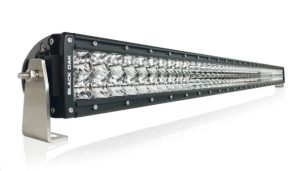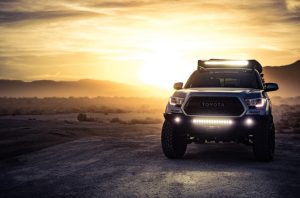Off-road driving, long-haul trucking, or even emergency use often requires more than standard headlights can provide. This is where light bars step in. Designed to deliver powerful illumination, light bars enhance visibility, improve safety, and add a rugged aesthetic to vehicles. However, choosing the right light bar isn’t as simple as picking the brightest or the largest one. Size, power, beam type, and placement all play crucial roles in performance and legality.
In this article, we’ll break down the key factors you should consider when selecting a light bar, explain the science behind beam output, and provide practical recommendations to help you make the best decision.
Why Use a Light Bar?

Light bars serve specific purposes beyond the capabilities of headlights:
-
Extended Visibility – Cover wider terrain in off-road environments.
-
Safety – Spot obstacles, wildlife, or hazards earlier.
-
Durability – Built for harsh conditions (dust, water, vibrations).
-
Customization – Add a rugged, professional look to vehicles.
From weekend off-roaders to utility trucks, the right light bar ensures better preparedness for low-light conditions.
Key Factors in Choosing a Light Bar
1. Light Bar Size
The physical length of the light bar dictates how much area it can cover.
| Size Range | Typical Use Cases | Pros | Cons |
|---|---|---|---|
| 10–20 inches | ATVs, UTVs, smaller SUVs | Compact, easy to mount, affordable | Limited range |
| 20–30 inches | Pickup trucks, mid-size SUVs | Balanced coverage, versatile applications | May require careful wiring |
| 40+ inches | Full-size trucks, off-road rigs, utility fleets | Maximum illumination, professional-grade | Bulky, higher power demand |
Tip: Don’t pick the largest bar without considering where it will fit and whether your vehicle’s electrical system can support it.
2. Power and Lumens
The wattage and lumen rating determine brightness and energy consumption.
-
Wattage (W): How much power the light bar draws.
-
Lumens (lm): The actual brightness output.
| Power Range | Lumens Approx. | Best For |
|---|---|---|
| 40–100 W | 3,000–10,000 lm | Small vehicles, recreational use |
| 100–180 W | 10,000–18,000 lm | Daily drivers needing better visibility |
| 180–300+ W | 18,000+ lm | Heavy-duty off-road, professional, industrial use |
Note: More lumens = brighter light, but also higher heat generation and battery load.
3. Beam Patterns
Beam pattern determines how light is projected.
| Beam Type | Description | Best Use Cases |
|---|---|---|
| Spot Beam | Narrow, long-range beam | High-speed driving, open highways |
| Flood Beam | Wide, short-range illumination | Off-road trails, work areas |
| Combo Beam | Mix of spot and flood | All-around visibility, versatile driving |
For most users, a combo beam offers the best balance between distance and width.
4. Placement Options
Where you install the light bar affects both performance and legality.
| Placement Location | Advantages | Drawbacks |
|---|---|---|
| Roof | Maximum forward coverage, ideal for off-road | Wind resistance, possible glare on hood |
| Bumper / Grille | Lower glare, balanced lighting | Limited range compared to roof |
| Behind Grille | Hidden, sleek appearance | Reduced brightness due to obstruction |
| Hood / Pillar | Supplemental lighting | Narrow angle, less coverage |
Tip: Always check local laws before mounting light bars on roofs or hoods, as some regions restrict on-road usage.
Additional Considerations
-
Color Temperature – Most light bars emit 6000K white light for daylight-like clarity, but amber options cut through fog and dust better.
-
Durability Ratings – Look for IP67/IP68 for water and dust resistance.
-
Wiring Harness – Ensure safe installation with relays and fuses.
-
Switch Control – Consider dash-mounted or wireless switches for convenience.
Common Mistakes When Choosing a Light Bar
-
Overpowering the Vehicle’s Electrical System – Installing a 300W bar on a small SUV can cause battery and alternator strain.
-
Ignoring Legal Restrictions – Some regions prohibit roof-mounted lights on public roads.
-
Wrong Beam Type – Using flood beams for highway driving reduces effectiveness.
-
Cheap, Non-Certified Products – Poor-quality bars may fail prematurely or cause glare.
Practical Recommendations

-
Measure available mounting space before buying.
-
Choose lumens based on your actual driving needs, not just maximum output.
-
Go for combo beams if unsure about specific conditions.
-
Invest in quality brackets and harnesses to ensure durability.
-
Regularly clean lenses to maintain beam clarity.
Conclusion
The right light bar is more than just a powerful accessory — it’s a carefully chosen upgrade that improves safety, enhances style, and ensures optimal performance for your vehicle. By considering size, power, beam pattern, and placement, drivers can find the perfect solution tailored to their needs.
For those looking to upgrade or replace their vehicle’s lighting system, high-quality options are available. You can Buy Car Lighting online to explore a wide selection of durable, efficient, and stylish light bars suited for all driving conditions.